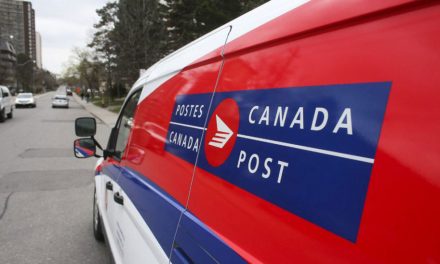
Canada Post makes small profit in better-than-expected second quarter

Canada Post made a small profit in its latest quarter, and said it was “encouraged” by the performance despite the ongoing challenges from Canada’s declining mail volumes. The state-owned company reported a pre-tax profit of $53m for the second quarter of 2014, turning around a $104m loss seen in the same period last year. Revenues for the core Canada Post business grew by 10.4% in the quarter, to $1.56bn.
The Canada Post Group as a whole, which also includes parcel firm Purolator, recorded an $86m pre-tax profit in the second quarter, up from a $76m loss in the same period in 2013. Group revenue in the three months up to the end of June grew by 9.5% to $2.01bn
The achievement means that despite the loss made in the first quarter this year, 2014 so far has been profitable for the core business of Canada Post, with a pre-tax profit of $26m achieved in the first half, compared to the pre-tax loss of $36m recorded in last year’s first half. Revenue for Canada Post grew in the first half by 3.5% year-on-year, to $3.03bn.
For the Group as a whole, the first half saw a $49m pre-tax profit, compared to a $25m pre-tax loss in the first half of 2013. Revenue grew 3.7% to $3.88bn.
The improved picture at Canada Post Group came courtesy of stamp price increases, the growth of the parcel business and better returns on the Group’s pension fund investments.
Nevertheless, spokesperson Anick Losier told Post&Parcel that efforts must continue to transform the company in light of expectations that letter volumes will continue to fall.
Since the beginning of this year, transactional mail volumes have fallen by 4.7% or 117m pieces compared to the same period in 2013.
The volume decline was lower than expected thanks to the impact of provincial elections in Quebec and Ontario.
“While we are encouraged by the results, there are no questions the decline in mail volumes will continue,” Losier said.
“We are doing everything possible to outpace that decline. With Canadians mailing less and ordering more parcels online, this fundamental shift is a main driver for the Five Point Action Plan announced last December, and we are making good progress with that.”
Transformation
Canada Post’s Five Point Action Plan aims to return the Group to financial self-sufficiency through measures including the conversion of properties currently receiving doorstep mail delivery to community mailboxes over the next five years. About 100,000 addresses are due to convert by the end of 2014, with 1.17m due in 2015.
The Plan included stamp price increases taking effect at the end of March 2014, which set a $0.85 price for stamps bought in bulk, while individually-sold stamps were set a $1 rate.
Other measures within the Plan include offering more postal counters through partner retail stores, modernising sorting and delivery infrastructure to cope with higher proportions of parcels, and a move to reduce the size of the company’s work force, “mainly through attrition”.
Second quarter
In the second quarter, Canada Post benefited to the tune of $58m from better investment returns from its pension fund, compared to the same quarter last year. In the year to date, the net reduction in the company’s employee benefit costs has been $113m.
Employee benefit costs are seen as “highly volatile and unpredictable” at Canada Post, and have a significant impact on the Corporation’s operating results as a whole. For the pension alone, Canada Post pays $250m a year in contributions, but has been granted relief by ministers from the need to make special payments to cover the pension fund’s $6.3bn solvency gap.
Canada Post saw its revenue from transactional mail — letters, bills and statements — rise by 14.3% year-on-year in the second quarter of 2014, to $823m, largely thanks to the price changes. In the first half, revenue rose by 3.5% to $1.6bn.
Direct Mail volumes grew in the second quarter, by 2% or 4m pieces, but in the half as a whole, revenue has fallen 2.1% to $595m, with volume down by 0.6% or 34m pieces.
Canada Post’s parcel business grew revenue by 11.3% to $353m in the second quarter, and by 9.2% to $694m in the first half. The company said that online shopping was offering a “tremendous opportunity” to grow the parcel business.
Domestic parcels saw revenue grow by 10.9% year-on-year in the second quarter, with volumes up 9.7% or 2m pieces. In the first half of the year, revenue grew by 8.4% with volumes up by 7.3% or 3m pieces.
Commenting on the company results, the Canadian Union of Postal Workers claimed that the higher than expected mail volumes and lower than predicted losses “prove” that the company should be looking to alternatives to cutting postal services.
The union is pushing for Canada Post to get into postal banking to boost revenues to support the rest of the company’s services.
Denis Lemelin, the CUPW national president, said: “When our post office has been profitable for most of the last two decades, the types of cuts that Canada Post and the Conservatives are trying to impose on us are completely unnecessary, We need to do what the rest of the world is doing and make the post office a better service, not a lack of service.”
Canada Post’s Purolator business saw its pre-tax profits grow 2% in the second quarter, to $27m, and by 3% in the first half, to $16m.











